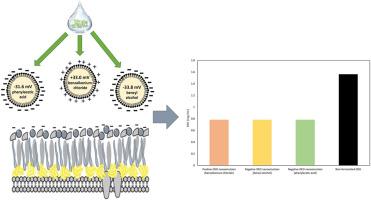Improved antifungal activity of Origanum vulgare L. essential oil in phospholipid-based nanoemulsions: Role of co-surfactants and surface charge
IF 4.9
3区 医学
Q1 PHARMACOLOGY & PHARMACY
Journal of Drug Delivery Science and Technology
Pub Date : 2025-09-28
DOI:10.1016/j.jddst.2025.107582
引用次数: 0
Abstract
This study investigates the antifungal efficacy of Origanum vulgare L. essential oil (OEO) encapsulated in phospholipid-based nanoemulsions (NEs) against Candida albicans. The formulations were developed using different amounts of soy phosphatidylcholine (SoyPC) and co-surfactants and/or charge-inducing agents, with the aim of enhancing the stability and bioactivity of OEO. Our results demonstrate that all nanoemulsion formulations significantly outperformed non-formulated OEO in terms of minimum inhibitory concentration (MIC) and minimum fungicidal concentration (MFC), regardless of surface charge. The inclusion of co-surfactants and/or charge-inducing agents was critical in maintaining the biological efficacy of the NEs over time, primarily by improving colloidal stability and enabling sustained release of the encapsulated active compounds. While cationic surfactants are typically associated with enhanced bioactivity, our findings suggest that stable, negatively charged formulations can achieve comparable antifungal activity without the potential toxicity of cationic agents. Replacing OEO with pure carvacrol allowed for a more accurate evaluation of formulation performance, highlighting the importance of release kinetics and structural integrity, rather than over surface charge, in determining antifungal efficacy. In addition, the study emphasizes the need for careful characterization of essential oil composition post-formulation and calls for further analytical investigation into the behavior of volatile components during emulsification. These insights are pivotal for the rational design and optimization of nanoemulsion-based antimicrobial systems incorporating essential oils.

提高牛油在磷脂基纳米乳中的抗真菌活性:共表面活性剂和表面电荷的作用
本研究探讨了磷脂基纳米乳液(NEs)包封的牛至精油(OEO)对白色念珠菌的抑菌效果。采用不同量的大豆磷脂酰胆碱(SoyPC)、共表面活性剂和/或电荷诱导剂开发配方,目的是提高OEO的稳定性和生物活性。我们的研究结果表明,无论表面电荷如何,所有纳米乳液配方在最小抑制浓度(MIC)和最小杀真菌浓度(MFC)方面都明显优于非配方的OEO。随着时间的推移,共表面活性剂和/或电荷诱导剂的加入对于维持NEs的生物功效至关重要,主要是通过提高胶体稳定性和使被封装的活性化合物能够持续释放。虽然阳离子表面活性剂通常与增强的生物活性有关,但我们的研究结果表明,稳定的、带负电荷的配方可以达到相当的抗真菌活性,而没有阳离子剂的潜在毒性。用纯香芹酚代替OEO可以更准确地评估配方性能,强调释放动力学和结构完整性的重要性,而不是表面电荷,以确定抗真菌效果。此外,该研究还强调了在配制后对精油成分进行仔细表征的必要性,并呼吁对乳化过程中挥发性成分的行为进行进一步的分析研究。这些见解对于合理设计和优化含有精油的纳米乳基抗菌系统至关重要。
本文章由计算机程序翻译,如有差异,请以英文原文为准。
求助全文
约1分钟内获得全文
求助全文
来源期刊
CiteScore
8.00
自引率
8.00%
发文量
879
审稿时长
94 days
期刊介绍:
The Journal of Drug Delivery Science and Technology is an international journal devoted to drug delivery and pharmaceutical technology. The journal covers all innovative aspects of all pharmaceutical dosage forms and the most advanced research on controlled release, bioavailability and drug absorption, nanomedicines, gene delivery, tissue engineering, etc. Hot topics, related to manufacturing processes and quality control, are also welcomed.

 求助内容:
求助内容: 应助结果提醒方式:
应助结果提醒方式:


